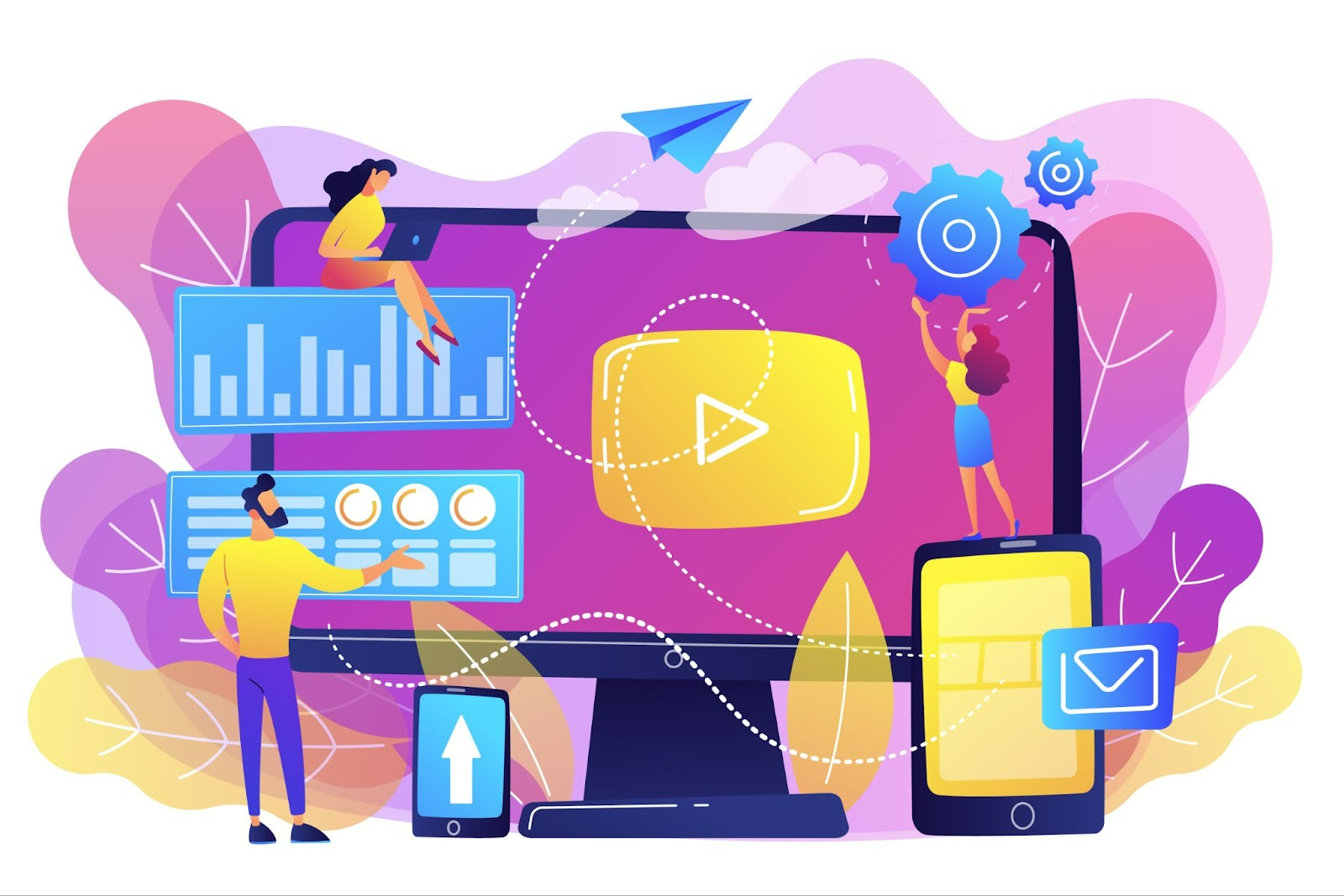
7 Digital Marketing Trends for 2024
There’s no exact formula to digital marketing success. It’s ultimately a trial-and-error process in which the only way you’ll find the best tactics for your strategy is to implement them to the best of your abilities and see if they stick.
And the only way you can do this is by following the best practices and being on the lookout for new and emerging trends to learn digital marketing.
Regarding the latter, you must always keep your ear on the ground for the latest tactics and strategies that could help your brand break through the upper echelons in your industry.
That being said, below are some of the more important trends that you should consider when developing your upcoming digital marketing strategy in the upcoming year.
#1 – Great Content Reigns Supreme
Google launched a series of product review algorithm updates in 2021. In a nutshell, the search engine encourages publishers to do the following for their product reviews:
- Showcase knowledge and expertise regarding the reviewed product or software.
- Establish standards for reviewing a product to help readers decide whether or not they should purchase it.
- Focus on the benefits of the product, not its features.
- Publish photos of products and screenshots of the software you’re reviewing.
- Include multiple links where people can purchase the product or tool. That means linking to online stores where you’re not an affiliate, which could lead to lost revenue.
These are just some of the many points included in the updates regarding product reviews. They are part of Google’s larger effort to provide its users with better and more engaging content ranking on search results. It encourages publishers and site owners to walk the extra mile and provide readers with the best information possible about the product software.
So, if you’re running a content marketing strategy, focus on the quality of published content and not the quantity. Instead of finding ways to take advantage of Google’s algorithm, dedicate your efforts to creating great content that stands the test of time. Eventually, they will rank on Google and drive more organic traffic to your website.
#2 – Gamification
Gamification is the application of typical game elements (e.g., scoring, competing with others, game rules) to other areas of activity, usually as an online marketing technique to encourage engagement with a product or service.
So playing a quiz, doing a photo scavenger hunt, placing Tetris blocks before entering data – all of these falls under gamification. Such gamification can be implemented seamlessly at events using an event app.
Gamification works well because it is fun and rewarding. As social people, we are deeply motivated by success and triumph. When people complete each task, they feel like they have accomplished something great. You can organize games with gamification on your social networks and offer gifts to the winners. We advise you to use a giveaway picker to choose your winners.
#3 – AI Content Will Get Better
Using AI content tools is an excellent way to move your startup marketing idea forward. While Google continues its pursuit to promote the creation of great and authentic content, it won’t stop publishers from using AI content generators to help them produce articles and blog posts.
The ease and convenience that tools like Jarvis, Rytr, and Closerscopy allow site owners to scale their content production without hiring multiple writers to get the job done.
Using AI content tools is an excellent way to move your startup marketing idea forward. The idea behind startups is to run lean and the mentioned tools help you cut back on costs without compromising the volume of content produced on your blog, social media, and other digital properties.
However, the quality of work produced by AI writers gets compromised. While they help speed up content production, site owners find themselves rewriting some of the pieces containing false information, incorrect grammar, and other writing weaknesses.
However, OpenAI allows easier access to GPT-3, the AI used for generating content with a click of a button, in the middle of this year. This move will allow more developers to create AI content tools and help established AI writers refine the results to help publishers create better content.
If anything, tools like Jarvis are the stepping stones with which people will measure AI content generators moving forward.
#4 – Audience Segmentation Becomes More Important Than Ever
Keep in mind that different segments compose your audience. Since each of your buyers belongs to different demographics, they don’t have to fit the same mold as everyone else.
At the same time, marketing to each of your segments will be different. For example, when marketing to teens, you need to compose a strategy that taps into their egocentricity and penchant for sharing content online and participating in causes they feel strongly about.
On the other hand, marketing to baby boomers requires the exact opposite strategies. They prefer content that doesn’t use slang or compelling stories, regardless of how long they are.
Both segments are at the opposite ends of the spectrum. But their differences convey the idea of creating specific marketing campaigns for the different segments of your audience.
For instance, build an email strategy using your marketing automation tool of choice in which you create campaigns for the different segments your brand accommodates.
Let’s say you have a weight loss website; you can create different campaigns such as:
- How to start losing weight now (for people who wish to start their weight loss journey).
- How to sustain their ideal weight (for people who achieved their desired weight and wish to keep it that way).
- How to develop a healthier lifestyle (for people who have or haven’t lost weight yet but want to improve their quality of life, which can be related to weight loss).
All three campaigns target particular segments of your audience, thus creating greater value for your website. The fact that you can provide these resources allows you to bring the people in your segments down your conversion funnel more efficiently.
Also, you can cross-promote the campaigns across your different segments to help improve your engagement with them, which could lead them to convert into customers.
Read More about a growth strategy that can improve your digital marketing in every segment to attract more customers.
#5 – Microinfluences Are Where the Money’s At
SEO and content marketing are indispensable tactics in your marketing strategy, but they take long before the positive results manifest themselves. Paid ads are much better in getting the results sooner than later, but ad blindness and other factors going against ads, in general, could cause your campaign to fail.
A tactic that can complement your strategy is using micro-influencers. You know them as people who receive hundreds and thousands of likes on Instagram and TikTok, among other social media channels. But underneath the surface, their ability to create content & posting them on social media accounts that engage and resonates with their audience is a sought-after skill among brands. They study and master the Facebook, Twitter, and Instagram algorithms to make sure they reach a wide audience. Scheduling Instagram posts will be the best option to engage more audiences on Instagram & other social media accounts.
With help from micro-influencers, businesses can deliver their products and services directly to people. The key to getting the most out of your influencer marketing campaign is by finding micro-influencers who share your exact audience. Promoting your product to people who match your buyer persona allows you to convert them into customers much more manageable.
At the same time, you have to determine how micro-influencers intend to promote your products in their posts. How your product will come across is indicative of how high or low your conversion rates will be.
#6 – Marketing Becomes Even More Conversational
Conversational marketing is the most logical progression stemming from personalization. Since customers respond well to a more personalized approach to marketing, nothing comes more personalized than talking to them as if they’re your friends.
More importantly, personalization now means instantaneous. Once your audience asks a question from your website, you should be able to respond within minutes, if not seconds, with the right answer.
Thankfully, conversational marketing can do this with the help of chatbots.
You can set up a chatbot on your website to automatically answer a set of questions. This way, your visitors won’t have to wait for your customer support to log in and answer them. Along with applying the right chatbot to your digital properties, you can also use the LinkedIn Automation tool to run connection and messaging sequences to grow your network and generate more leads on the platform. Enhancing your conversational marketing with top email analytics tools is crucial. These tools provide insights into email performance, helping you create timely and personalized content.
Ideally, you must determine the most frequently asked questions your business receives from your audience. Then create a knowledge base with posts answering each question. So, when someone asks the most common questions to your chatbot, it will lead them to pages in your knowledge base that answer them.
Another benefit of chatbots is you don’t have to build a customer support staff who will answer customer questions 24/7. It’s possible to provide excellent support to your audience at all times without the exorbitant costs of hiring multiple people for the job.
Online reputation management is another form of conversational marketing you need to watch.
The relationship between your brand and target audience is a dialogue. If someone doesn’t like your business for whatever reason, it doesn’t mean it’ll stay that way forever. The same thing goes for your brand advocates—they may dislike your brand sooner than later.
This social media marketing strategy aims to get ahead of the conversation about your brand and control the narrative. Reaching out to reviews and testimonials on social media about your business allows you to mitigate the bad ones and promote the good reviews.
Regarding customer posts with a negative sentiment, you must spin the situation into a positive experience for the customer. Ask why they feel that way and fix the problem. If you can’t make your customers change their minds about your brand, chalk it up to experience and keep their feedback in mind in your next campaigns.
#7 – Integrating Cryptocurrencies Into Your Digital Marketing Becomes a Thing
The current popularity of non-fungible tokens (NFTs) comes from cryptocurrencies making waves in the market. People are familiar with these virtual currencies as investment properties due to their increasing value over time. However, they have their real-world uses as well in the marketing space.
Marketers can tap into blockchain to gather user information into digestible marketing reports to help them create highly targeted digital marketing strategies that have high chances of conversions.
For instance, the Basic Attention Token (BAT) built on the Ethereum blockchain provides a way for creators and advertisers to make money, as well as users simply giving their attention to watching the ads. Users also have the power to decide which ads they want to view. Advertisers must then find ways to create ads that people want to see through this process. As a result, creators can display ads on their platforms that don’t disrupt the browsing experience since users volunteered to view the ads.
This example is just one of the many possibilities cryptocurrency brings to the table. Also, nothing’s set in stone, and BAT may not be in full swing in 2022. For instance, the rise of BAT could make launching ad campaigns even more challenging due to the potential decrease in ad reach, especially if users forbid marketers from gathering and using their data.
Nonetheless, the seeds have been planted for the idea of cryptocurrency in digital marketing. It will only be a matter of time before cryptocurrency becomes the norm as part of your digital marketing strategy.
Conclusion
The marketing landscape is always in flux, and that’s a great thing. Brands must adapt to the ever-changing needs of their audience so they can deliver the value that will help grow their revenue.
This is why these yearly trends that constantly change help keep your knowledge of the different marketing tactics up to date.
From here, you can separate yourself from people who commit to the same marketing efforts that could stunt your growth. Or you could choose other digital marketing strategies that could finally help propel your brand to the top.



